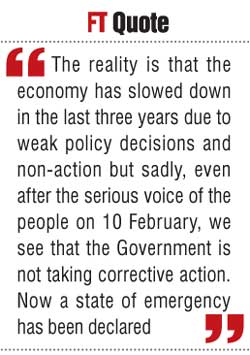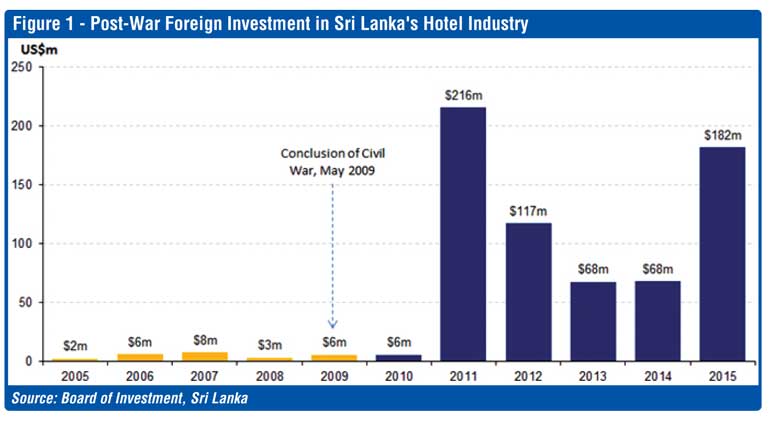Wednesday Dec 24, 2025
Wednesday Dec 24, 2025
Thursday, 8 March 2018 00:00 - - {{hitsCtrl.values.hits}}

The recent incidents in Ampara, Teldeniya and Digana and the declaration of a state of emergency for 10 days across the country was very disturbing to me personally given that I was part of the larger team that fought the ruthless terrorist organisation in Eelam war IV that brought peace to this country.
I still remember the many times I had to travel on military aircraft with the soldiers going to war at the height of the ground operation while I was in the Government Peace Secretariat between 2007-2010. As a team, we supported the soldiers on the ground by staging industrial exhibitions and sporting tournaments in Jaffna. We also ensured that the private sector remained engaged in Jaffna but now I wonder if this effort was worth it with the new terror unleashing whilst the country is heading down the economic agenda in the last three years.
Sadly even after the serious voice of the people on 10 February we see that the Government is not serious about taking corrective action.
How the LTTE started
In 1983 Prabhakaran apparently had only 12 cadres and just 20 shotguns but by 2006 the LTTE had amassed aircraft, tanks, submarines, missiles and a brigade of more than 20,000 that wiped out a minimum $ 200 billion of development work from the Sri Lankan economy. It’s important to go back in time and understand the cost of components that resulted in such a high cost of the war and the importance to stem it at early stages.
Economic terrorism – GDP
It is estimated that $ 3.5 billion was required to rebuild the Northern Province post the war. On the other hand if we compute the taxes that had been levied on the A9 road by the LTTE when the private sector transported goods from the south to the north during the years the LTTE was in control of the Wanni, it will sure run into billions of dollars that cannot be calculated.
In terms of opportunity cost during the peace dividend between the periods of 2002-2004, the GDP in the Northern Province quadrupled to 12.6% while in the Eastern Province it doubled to 10.1%, which is the pent-up demand that existed in that part of the country due to the 20 years of war. If this is calculated in, it will be around $ 3-8 billion annually (as per national GDP values at that time). If we use the same computation to the ongoing violence in Teldeniya, etc., we can once again compute the cost of terror in Sri Lanka that could be avoided with early action.
Economic terrorism – Quality of life
Another interesting dimension in calculating the cost of a backlash is, in 2003/2004 the Socio Economic indicators reported that the access to pipe-borne water in the Northern Province was only 3.1% whilst in the east it registers 17.4%. The national average stands at a high 30.8%. The non-accessibility to toilets which is a stronger indicator of the quality of life stands in the north at 14.4% and the east, a staggering 29.2% whilst the national average stood at a respectable 5.6%, which again is a result of economic terrorism that has been at play in the last 24 years.
As per the labour force survey of 2002, the labour force participation is at 50.3% nationally, whilst in the north it drops to 33.8% and in the east to 40.3%, which can directly be reflective to the cost of terror on a qualitative front when terror eats into an economy.
Economic terrorism – Tourism/FDIs
 If we pan into the tourism industry, way back in 1983 Sri Lanka enjoyed 337,530 visitor arrivals whilst a country like Cambodia had around 200,000 tourists at that time. In 2009 Cambodia enjoys over two million tourist arrivals whilst Sri Lanka is at around 0.5 million with a revenue of Rs. 43 billion.
If we pan into the tourism industry, way back in 1983 Sri Lanka enjoyed 337,530 visitor arrivals whilst a country like Cambodia had around 200,000 tourists at that time. In 2009 Cambodia enjoys over two million tourist arrivals whilst Sri Lanka is at around 0.5 million with a revenue of Rs. 43 billion.
Technically, by 2009 Sri Lanka should have had recorded around 1.8 million tourists at a very conservative estimate whilst earnings should have touched Rs. 200 billion. On a GDP contribution basis it would have contributed almost 8% to the country. These are the actual numbers that add to the numbers of the concept economic terrorism that has been ravaging Sri Lanka and we see once again raising its head with the sporodic incidents in Jaffna through the AVA group and incidents in Teldeniya.
The Strategic Foresight Group which has researched this topic on the theme ‘Cost of the War in Sri Lanka’ has estimated through a simple extrapolation that the loss of revenue due to the curtailment of FDIs into the country is around Rs. 3,000 billion, which stacks up to the economic terrorism number that I have highlighted above. We also see from a BOI study done in Figure 1, how investments into tourism spiked from 2011 onwards to $ 651 million till 2015 which means by 2017 would have crossed the $ 1 billion mark.
If we examine the FDI inflow to Sri Lanka, it has been fluctuating widely during the last 24 years with the overall performance being below the set targets and way below the performance of the regional counterparts. It is estimated that Sri Lanka has lost around $ 3 billion on FDIs during the last 24 years, mainly due to the war.
If one digs deeper it could be said that there is a strong relationship between the security situation and the FDI flow into the country. Especially in the 1987-1989 periods, the trend was very evident but thereafter in the 1990s there was a surge in the inflows due to the higher business confidence experienced.
But after the TNT-laden truck of the LTTE rammed into the Central Bank in 1995, there was another drop experienced in the flow of FDI that clearly reflects the impact of terrorism on a country that needs higher visibility, especially a developing country like Sri Lanka.
We will see this trend in Sri Lanka once again, post the Teldeniya incident and the declaration of emergency in the country unless some serious action is taken correct the deteriorating policy environment in the country.
Economic terrorism – R&D
For argument’s sake if we take the Rs. 400 billion that that was spent on the war in the period 2007-2009 and divert it to the investment that could have been made on Research and Development (R&D), the numbers will stack up to almost 7% of GDP. This would beat the 4% GDP spend that economic tigers like South Korea invested to build power brands like Samsung. This gives us an idea of the opportunity cost that economic terrorism has had in making Sri Lanka an innovation hub for South Asia.
Economic terrorism – Apparel
A point that can contribute to the concept of economic terrorism in the apparel sector is as follows. If we analyse the Revealed Comparative Advantage (RCA) score for Sri Lanka we see that Sri Lanka scores a high of 16.7 on being a supplier of clothes but scores a low 1.05 on being a textile supplier.
This can be attributed to the non-strategic direction in which this industry has been developed by the State in the 20 years of war due its focus on containing the LTTE. We once again see the situation going on this direction from a macro policy perspective post the 10th of February as the ethos is more on how to be in power than on making the changes to drive the economy.
Economic terrorism – The Rice Bowl
If we take the agriculture sector, Mannar District boasts a 120 square km land area called the Rice Bowl, which was also called the green patch some years back. This rich land area grew the highest yielding paddy that Sri Lanka produced as way back as 1991. The economic terrorism that existed stifled the growth of this area in the recent past and left policymakers unable to make use of the 150 natural reservoirs fed by the Yoda Wewa to be utilised for other agricultural crop development.
If we extend this argument to the tea industry and the glyphosate issue, even after year and research has shown there is no direct link to the health issues, the policymakers have not taken a decision resulting in the industry in a catch-22 situation. I guess no charges will be made in the next yen days too as the focus will be on the security situation of the country.

Next steps
Hence we see the impact of economic terrorism that ravaged the country for over 25 years. If we were to add all these impacts, the total will exceed $ 200 billion, which happens to be almost three times Sri Lanka’s current GDP value. We cannot have another back lash but from the current trends it looks like the current government has lost its grip on the country.
I believe the vision for this country is that we should be zero poverty, zero unemployment and zero child mortality country whilst boasting economic growth of 7-10% in the years to come. This should be coupled with clear industry strategies on a prioritised basis so that Sri Lanka is in the making of being an ‘Economic Tiger’ in Asia. The challenge is, can the current Government take the tough decisions even after the 10 February people›s voice?
[The writer was the Director Economic Affairs of the Government Peace Secretariat from 2007-2010 and thereafter served the United Nations (UNOPS) for over five years and was instrumental in setting up the Atchchuveli Industrial Zone in Jaffna (the first post-war industrial estate in the Northern Province). He currently serves on many private and public sector boards as a director. The thoughts are strictly his personal views.]